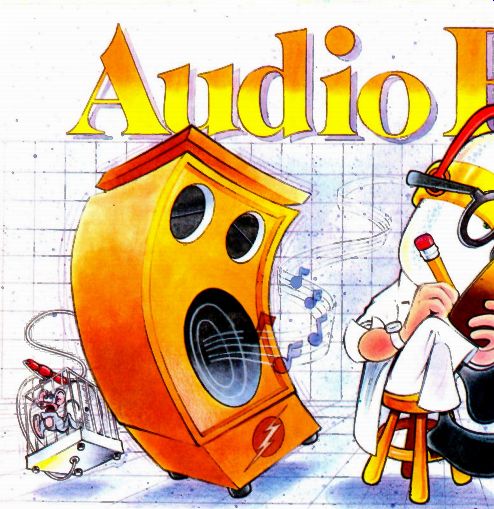
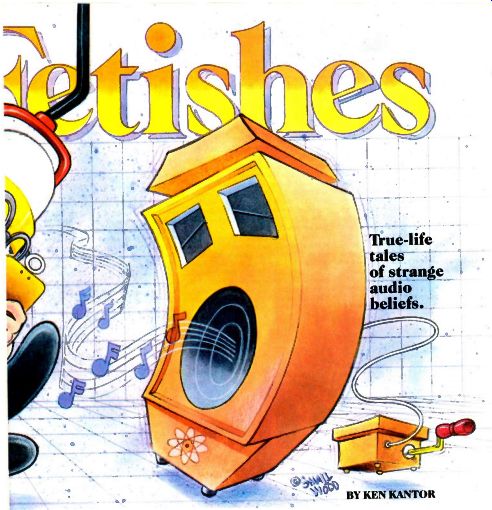
True-life tales of strange audio beliefs.
BY KEN KANTOR
TRUE STORY NO. 1
Date: the fall of 1978. Place: a state-of-the-art audio research laboratory at a major East Coast technical institution. (Hint: There is only one.) An awesome collection of eminent audio professionals has been assembled as test subjects for a definitive listening experiment. The procedures have been defined and refined, the equipment checked and double-checked. No reservations remain concerning the hardware, the software, or the experimental method. Attention is focused on a group of audio critics, writers, and engineers--all reputed to be among the most astute and demanding "golden ears" on earth. They are a confident bunch. They believe that finally they have been given their proper chance. They can now answer definitively one of the great, burning audio questions of the decade: Do discrete transistors sound better than integrated circuits? As months of anticipation, speculation, and planning come to a climax, the appointed leader is handed a small box on which sits a silver toggle switch with positions labeled TRANSISTOR and IC. A wire from the box disappears into a control system in the wall. Never in history has more effort gone into the creation of a noiseless, seamless, absolutely pure and undetectable audio-switching system. With notebooks in hand, the experts disappear into the acoustically prepared room for the beginning of two full days' un-disturbed music listening. Their only mission: to choose which of the two switch positions offers the better sound.
At first the golden ears seem distraught, but they are only warming up. As the hours roll on, spirits lift and a consensus begins to emerge. In due time the consensus be comes a treatise of two dozen pages, rich with the language of the engineer and of the poet. It is unanimous: Transistors have won. The poker-faced scientist who graciously accepts the report is afraid to tell the assembled golden ears the truth: that the box contained nothing more than a switch and a lump of clay to add a convincing heft. It was not connected to anything! What is the moral here? Are we foolish to trust our ears? Are "golden ears" all fakes? Does all audio equipment sound the same? All of the above? No, the moral is definitely: None of the above. The lesson is simply that humans can be fooled, by themselves and by each other-not all the people all the time, but enough to merit taking a closer look at some of the ways mistakes can occur. Audiophiles invest a lot of passion in their beliefs about the various techniques, philosophies, and, most of all, equipment associated with sound reproduction. Fetish, while a strong word, is an appropriate one describing many audiophile beliefs: as one dictionary has it, "an object regarded as having magical power; any object or idea eliciting unquestioning reverence or devotion."
Audio fetishes evolve in a basically logical way. A clever hobbyist wakes up with a revelation about how to improve his stereo system. Such ideas are usually inspired by perceived technical deficiencies, real or imagined. For example, the hobbyist, dissatisfied with the sound of his system, might begin to wonder whether the tediously slow chemical reactions occurring in the electrolytic capacitors in his amplifier might be blurring musical transients. A fix using high-grade and expensive poly propylene capacitors is planned and executed.
Naturally, the proud and excited audiophile expects to hear a vast improvement. Providing that no damage has been done to the operating circuitry, it is a pretty good bet that the sound will indeed seem much better. A five-minute demonstration to admiring friends and relations, some of whom never heard the unmodified amplifier, reinforces that perception. The hypothesis is proven. A fetish is born. One of his friends knows a writer for an "under ground" audio publication, which uncritically promulgates the idea worldwide. An engineer in Japan reads about it and convinces his management that polypropylene capacitors will help sell his new amplifier in the tough American market. The full-color cross-Pacific polypropylene amplifier promotional barrage begins- even in the pages of HIGH-FIDELITY. The truth is that our hobbyist has no real way of knowing what he has wrought, be it better, worse, or indifferent. The original capacitors may have been doing a splendid job all along, and no real change has been effected. Surely nobody familiar with controlled listening tests and the du ration of auditory memory would trust the hobbyist's listening-test results, even disregarding his possible bias in the matter.
Perhaps the amplifier had originally been designed for a particular type of capacitor and the new one actually produces a rising high end, which, in turn, is interpreted as improved transient response. The listener is happy, but his amplifier is now less accurate and possibly unstable.
Over the years, many similar mystical notions have floated through the audio world. Proponents of these beliefs often cite some technical or pseudo-technical rationale in support of their position. Rarely does any hard experimental evidence exist of the kind that would eliminate personal bias from the equation. And open-minded compromise seems out of the question: All too often, champions of the measure-up or-shut-up approach dismiss subjective listeners as, at best, self-deceiving flakes or, at worst, self-serving charlatans. The ears-uber-alles types, on the other hand, usually consider the loyal opposition deaf and insecure. Some go so far as to deny the ability of any conceivable experiment to convincingly prove or disprove their claims. Thus, the rest of us either hear what they hear, or we are, by definition, wrong.
So, how can you know what or who to believe? After all, there must be some degree of truth behind even the strangest audio fetishes, even if it is only that somebody somewhere thought he heard the effects claimed. It is logical that any time you change something-a piece of equipment or merely a piece of wire or cable-some kind of an audible effect should result. The trick is to know whether that effect is real or can be explained by other factors; whether it is big enough to hear at all; and whether it is actually a step in the right direction (toward accuracy or whatever other criterion of sonic quality you may de sire). While there are never definitive answers to these questions, there are three meaningful parameters by which you can judge whether an audio fetish has some basis in reality: Mechanism. How is the effect supposed to alter the electrical or acoustical signal? Magnitude. If there is an effect, is it big enough to be heard according to the known capabilities of the human hearing system and big enough not to be over whelmed by other effects in the chain? Evidence. Is the evidence in support of the effect reliable and experimentally derived (whether from controlled listening tests or through lab measurement), or is it purely anecdotal and entirely subjective? Whole clusters of audio fetishes be come suspect when the mechanism criterion is applied to them. It's like astrology: It seems, somehow, reasonable that astronomical processes might exert influence on our lives-until you really ask how.
Which of the known physical forces or laws are coming into play? Is there a previously unknown force? If so, what is its nature? It's the same as when people tell you that a digital watch or a telephone in the listening room can ruin the sound of a stereo system. Sure, but how? The second test to apply is to relate claimed performance improvements to the known performance limits of the human hearing system and to other limitations of the sound-reproduction chain. While many (though not all) alterations to a stereo system will produce small measurable changes, such changes often fall far out side the scientifically defined limitations of the ears' ability to hear. Or the alterations may be swamped by changes introduced by a more flawed component. It i hard to get worked up about the tiny deviations from flat frequency response found in CD-player output filters, when they are ten or a hundred times smaller than the response variations found in the best monitor speakers.
As a soft little real-time spectrum analyzer, the human ear is a pretty remark able piece of test gear. Our hearing system is capable of processing information over a power range of more than a million-million (10^12) to one. It can distinguish and track a multiplicity of interwoven signals better than the best supercomputers. I can determine sound location and details of the physical environment from a brief listen to a totally unfamiliar sound source.
And it can make very subtle judgments about tonal balance even in the presence o high-level noise.
But we cannot hear everything. Human ears, like their electronic-measurement counterparts, are not infallible. Just as it is difficult for an instrument to "hear" dynamic range, the ear is not particularly good at judging phase shifts or even harmonic distortion. Even with the most revealing signals known, the ear can't detect an intra-channel phase delay of less than about two milliseconds. This is so far greater than anything found in amplifiers, cables, CD-player output filters--and even so much greater than non-"time aligned" loudspeakers--that it appears safe to ignore claims related to it. Inter channel phase errors can affect imaging; but that is really a different issue. In a similar way, any claims for audible performance improvement directly attributed to distortion below 0.1 percent is misplaced. The ear ignores it.
The third, and most difficult, way to assess a fetish is to consider exactly what kind of evidence exists to support it. Just as the power of the brain gives the ear its unique abilities, it is the complexity of the brain that can color data with sensory distractions and psychological influences.
From an equipment designer's point of view, this is a very frustrating situation.
On one hand, the ear is the best all-around instrument available for audio testing; it i often the only instrument capable of making some necessary tests. On the other hand, ears are usually attached to listeners, and listeners are very subjective, are easily fooled, and can make mistakes.
Even though it is very easy to hear what one expects to hear, regardless of the sound waves hitting the eardrums, subjective listening is still a very valuable process, especially when choosing, for in stance, which loudspeaker does the most convincing job playing back a certain re cording. Perceptions and opinions are a perfectly valid basis for making purchasing decisions or for writing equipment re views. Furthermore, subjective impressions often clue engineers about the existence of real, measurable phenomena previously unknown, disregarded or otherwise dismissed.
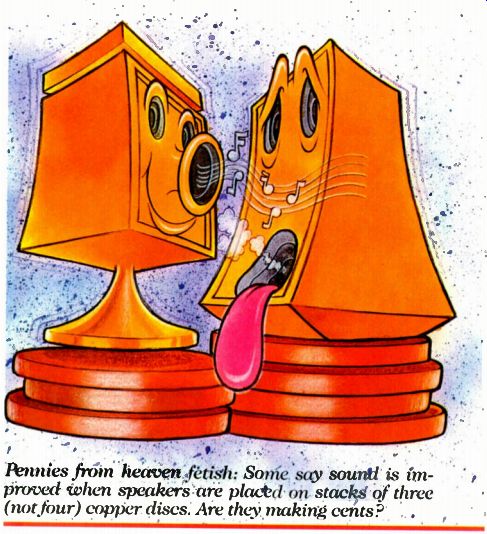
-------- Pennies from heaven fetish: Some say sound is improved
when speakers are placed on stack of three (not four) copper discs.
Are they making cents?. -------------
Where subjectivity is less desirable is when one attempts to develop a scientific understanding of a given phenomenon in order to eliminate it, reproduce it, or even increase it, depending on whether it is deemed desirable or not. Plain listening can, at best, reveal only the audible aspects of a phenomenon; it is the job of experiments to uncover the underlying causes.
For example, a researcher may be trying to determine which of two amplifiers delivers a flatter frequency response under a certain set of conditions. This researcher is not, for the moment, interested in whether all amplifiers sound alike, which amplifiers sound better, or even whether flat response amplifiers sound better in general. Those valid questions may arise later, but for now it is only important to know whether a new circuit design produces a desired result.
In this kind of "yes or no" situation, subjectivity complicates matters tremendously. Imagine the difficulty in answering this simple, straightforward question with a listening panel! While expert listeners can make complex overall judgments about sound quality, the answers to simpler questions are often more useful to people trying to improve the design of audio products. If one knows only that an amplifier sounds better, and not exactly why, it may be very hard to duplicate the sound in future products, or to lower costs while maintaining the best possible fidelity. (For examples of the mechanism, magnitude, and evidence criteria in action, see "Classic Case Histories," p. 58.)
------------
Classic Case Histories
The following case histories all revolve around true audio fetishes: The beliefs involved have appeared in print as serious propositions. But each one can be seriously questioned using at least one of the three criteria for judging the plausibility of an audio fetish (mechanism, magnitude, or evidence).
FETISH: Stereo systems sound better when they are powered from AC produced by hydroelectric generators than when powered by AC from nuclear generators.
Rationale: The nuclear-fission reactions are somehow imposed on the waveform structure of the AC power.
This causes deterioration of the signals in amps and preamps.
Rebuttal: Why can't the effect on the AC be measured or seen in any way? How does it manage to pass through the myriad transformers between the power station and the home, and then through the amplifier's power supply? And, since power companies mix and match power from numerous generating stations of different types, how do you even know what kind of AC you are "hearing"?
FETISH: Reproduced music that was digitized at any stage of the recording process can cause neurological damage when heard.
Rationale: The human hearing system is essentially analog, and is thus incompatible with the step-wise nature of digital audio.
Rebuttal: It is straightforward to prove mathematically, from the work of Fourier and others, that the correctly filtered output of a digital sampling sys tem such as that used in the CD or DAT systems has absolutely no residual step-wise behavior-it is analog. Be sides, the hearing system, being based on nerve impulses, is actually some what "digital" in nature.
FETISH: A component's frequency response in the upper ultrasonic range can influence the audible harmonic structure of reproduced music.
Rationale: The perception of harmonics in the audible frequency range is very dependent on the presence of harmonics in the ultrasonic range. Also, ultrasonic sounds can be "modulated" down to audibility by reflection.
Rebuttal: The ear cannot hear, and is not affected by, sounds above 20 or 25 kHz, at most. Period. Recorded music doesn't generally have energy much above 20 kHz, so there is nothing ultra sonic to reproduce. And ultrasonic energy cannot become audible through reflection.
FETISH: Flat frequency response alone guarantees accurate sound reproduction.
Rationale: Spectral response dominates audio perception; thus a flat spectrum means accurate perception.
Rebuttal: While it is true that spectral factors dominate hearing, the belief assumes a procedure for measuring frequency response that is representative of what the ear hears as "frequency response"--not a good assumption for loudspeakers or ambience-enhancement systems. It also assumes that the measurement conditions are representative of listening conditions-not al ways true with amplifiers. This belief also ignores the effects of noise, distortion, and those, admittedly second order, of time response.
FETISH: The interchannel delay of a few microseconds present on some types of CD players can seriously disturb stereo imaging.
Rationale: Stereo imaging is dependent on inter-ear signal timings as short as a few microseconds.
Rebuttal: The interchannel delay imposed by this type of CD player is equivalent to one speaker being about 1/4 inch closer to the listener. Provided that the preamp is not switched to mono (which would cause a tiny drop in high-frequency response), the delay is thus a minor effect at best.
FETISH: Distortion less than 0.1 per cent is audible (a common belief of amplifier manufacturers, especially those touting components with distortion less than 0.1 percent). Rationale: Distortion less than 0.1 per cent is audible.
Rebuttal: Distortion less than 0.1 is never audible (it has never been shown to be so in scientifically controlled listening tests). FETISH: Speaker wires of differing construction can result in different speaker sound, even if their resistance, capacitance, and inductance are close to identical.
Rationale: Different wires have different transient and phase responses.
Rebuttal: To an electrical engineer, identical resistance, capacitance, and inductance mean identical transient and phase response. Anyway, the ear isn't very sensitive to phase.
K.K.
---------
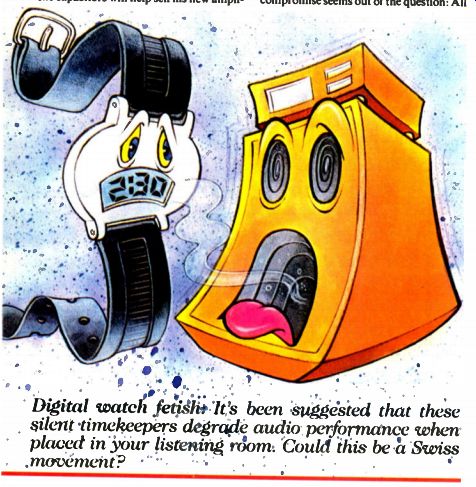
------ Digital watch fetish. It's been suggested that these
silent timekeepers degrade audio performance when, placed in your listening
room. Could this be a Swiss movement?
------------------
TRUE STORY No. 2
Date: the early 1950s, even before stereo.
Names like G.E., Pickering, and Fairchild dominate the "high-end" phono-cartridge market. Over the mundane sapphire styli more commonly supplied, discerning audiophiles develop a preference for the sonic virtues of diamond. Major manufacturers begin to sell premium diamond versions of their cartridges, and one enterprising small company runs a classified ad offering a diamond upgrade to existing equipment by mail.
When Tom (not his real name) saw this ad, he knew it was the answer to his prayers. He had become dissatisfied with his hi-fl system of late and had the intuitive sense that his cartridge was to blame.
True, $10 was a lot of money, but it was still somewhat less than one of those new diamond rigs. And if the results proved even close to the "smoothness," "vivid ness," and "transient response" promised in the ads, his hi-fl would surely sound perfect again. He answered the ad and in a few weeks received, as promised, a carefully packed diamond-stylus assembly.
Now, Tom was a scientist -an entomologist (insect scientist) by training- but he was not an audio engineer. As bug like as the stylus appeared, he still did not want to risk the possibility of damage or degraded performance from improper installation. So he called on the services of his friend Bill, who was a bright young engineer for a local audio manufacturer. Bill and his assistant arrived one Saturday to perform the necessary operation.
Unfortunately for Tom, Bill also fancied himself something of a scientist, and he decided to perform a devious experiment. Though appearing to labor closely over the cartridge, he did not remove the old sapphire needle. After a time, he announced that all was ready to hear. Tom went to his record collection and selected his most critical evaluation disc. As the music blossomed forth from the lone loud speaker (mono, remember?), a smile Bill described as "beatific" blossomed forth on Tom's face. "This is what I have missed for years," he exclaimed. "It's heaven!" But Bill was not finished. "Just for the sake of science," he said, "let's put the old needle on for comparison." Of course, Bill now put on the diamond stylus, and Tom was aghast at how he could have ever considered such cacophony to be hi-fl. Eventually, Bill had to 'fess up. And although he had expected annoyed amusement, he found himself faced with almost violent anger. His friend (former friend?) was not enlightened one bit. He wasn't angry at himself or the mail-order firm. He was angry at Bill for tricking him in such a devious way-perhaps knowing that now his hi-fl just would never sound the same again.
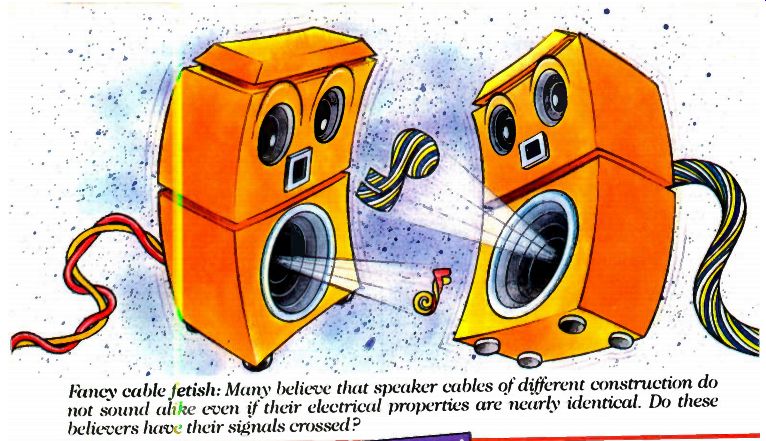
------ Fancy cable fetish: Many believe that speaker cables of different
construction do not sound alike even if their electrical properties
are nearly identical. Do these believers have their signals crossed?
-------
What's Your Fetish?
Tell us and we'll give you a chalice to win a pair of NHT loudspeakers.
That's right, friends, step right up to the opportunity of a life time! The reader who submits the best audio fetish -- the funniest, most outrageous oddball idea--will win an NHT three-piece loudspeaker system, comprising two Model I satellite speakers and an Octave bass-extension module. Runners-up (as many as are deserving) will receive two-year subscriptions (or extensions) to HIGH FIDELITY And naturally, all winners will see their entries featured, with full credit, in a future issue. The rules are simple: Briefly describe your fetish, including both the phenomenon and a supposed explanation. Please try to hold this to a few sentences, clearly written or (preferably) typed on a single sheet of paper along with your name and address. Mail it to: HIGH FIDELITY, Dept. AF, 825 7th Avenue, New York, N.Y. 10019. The fetish itself can be something you've heard or read about or even something you've made up. Entries will be judged by the editor, of the magazine, largely on the basis of what makes us laugh hardest. Entries mw-t be postmarked no later than October 30, 1988, and become the property of HIGH FIDELITY magazine. Winners will be notified by mail. Employees of ABC Publishing, NHT, and Product Design a id Evaluation Services --as well as their families, friends, and therapists--are not eligible. Which is too bad, because I know a real dilly. -Michael Riggs
------
------
TRUE CONFESSIONS
Now that the cynical side of the coin has been examined, I have to say that I really think fetishes and mysteries are a big part of what makes audio so much fun. Bill, in the preceding drama, certainly had a good time, even if Tom did not. Music just isn't the whole motivation for becoming an audiophile, any more than transportation is the whole appeal of a sports car. Audio lovers listen to music; and, admit it or not, they listen to equipment too. They enjoy fussing with their systems. And, once in a while, a wacky idea turns out to be dead right.
Every true audiophile-including the most scientific of them--has a few secret fetishes, and even blatant lapses of logic.
Like the time, at age seven, I totally destroyed my father's new power amplifier a few days after he explained to me that its job was to "make the electrical signals larger." You see, I already knew that resistors sort of blocked electrical flow, and I figured that if I removed them all, the amp would work much better.
Too bad my father didn't see it that way. It only goes to show that you can't always trust your calculations in these matters. And just recently I've developed a secret technique in which I spend a minute or two walking slowly around a room, sensing in my mind exactly how a new pair of speakers should be placed for best sound--even if I have never heard them. I can't explain why, but it seems I am always right. Always. So don't try and tell me I'm not!
Ken Kantor is a co-founder of Now Hear This, a California speaker manufacturer. He also serves as president of Product Design and Evaluation Services, an audio consulting company.
Also see:
Bits & Pieces -- The real reason to want an 18-bit CD player. (Jan. 1988) DAVID RANADA
Ultra High Fidelity Recordings Sounding Off -- An Interview With Bob Carver Of Carver Corporation